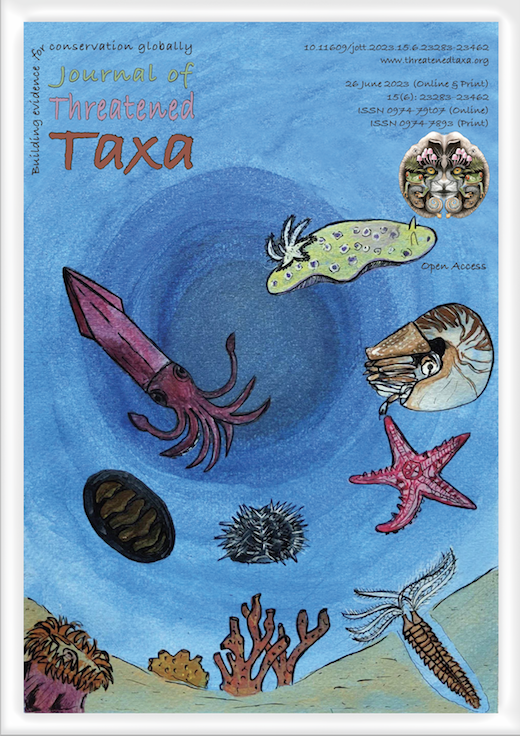Diversity and abundance of aquatic birds in Koonthankulam village pond, Tamil Nadu, India
DOI:
https://doi.org/10.11609/jott.6612.15.6.23297-23306Keywords:
Koonthankulam, avian fauna, migrants, principal compound analysis, Structural equation modelingAbstract
The diversity of birds in Koonthankulam pond, located in Koonthankulam village (8.495N, 77.755E), Tirunelveli district, southern Tamil Nadu, was studied. A total of 90 species belonging to 21 orders, 42 families, and 73 genera were recorded. The study recorded seasonal migrants such as Black Ibis, Oriental White Ibis, Bar-headed Goose & Spoonbill and indigenous species including the Pond Heron, Cattle Egret, White-breasted Kingfisher, Red-wattled Lapwing, Rose-ringed Parakeet, Purple-rumped Sunbird, Hoopoe, and Indian Robin. The primary data were analyzed by principal component analysis, cluster, and analysis of variance. Analysis of variance showed that the Menhinick index is statistically significant P <0.05. A structural equation model was applied to analyze the physico-chemical parameters of water samples collected from the sampling site. Analysis of experimental data through the structural equation model indicates temperature and dissolved oxygen may indirectly affect bird diversity.
References
Ali, S. & S.D. Ripley (1981). Handbook of the Birds of India and Pakistan: Together with Those of Bangladesh, Nepal, Bhutan and Sri Lanka Vol. 2: Megapodes to Crab Plover. Oxford University Press, USA, 347 pp.
APHA (2005). Standard methods for the examination of water and wastewater. 21st Edition. American Public Health Association, American water works Association Water Environment Federation, 541 pp.
Arbuckle J.L. (2012). IBM SPSS Amos 21 user’s guide. IBM Corporation, Armonk.
Belkhiri, L. & T.S. Narany (2015). Using multivariate statistical analysis, geostatistical techniques and structural equation modeling to identify spatial variability of groundwater quality. Water Resources Management 29(6): 2073─2089. https://doi.org/10.1007/s11269-015-0929-7
Buckton, S. (2007). Managing wetlands for sustainable livelihoods at KoshiTappu. Danphe 16(1): 12─13
Byrne, B.M. (1998). Structural Equation Modeling with LISREL, PRELIS and SIMPLIS: Basic Concepts, Applications and Programming. Psychology Press, New York, 432 pp. https://doi.org/10.4324/9780203774762
Byrne, B.M. (2001). Structural equation modeling with AMOS, EQS, and LISREL: Comparative approaches to testing for the factorial validity of a measuring instrument. International Journal of Testing 1(1): 55─86. https://doi.org/10.1207/S15327574IJT0101_4
Byrne, B.M. (2010). Structural equation modeling with AMOS: Basic concepts, Applications, and programming. Routledge, New York, 416 pp. https://doi.org/10.4324/9780203805534
Dauda, T.O., M.H. Baksh, & A.M.S. Shahrul (2017). Birds’ species diversity measurement of Uchali Wetland (Ramsar site) Pakistan. Journal of Asia-Pacific Biodiversity 10(2): 167─174. https://doi.org/10.1016/j.japb.2016.06.011
Duclos, T.R, W.V. DeLuca & D.I. King (2017). Direct and indirect effects of climate on bird abundance along elevation gradients in the Northern Appalachian mountains. Diversity & Distribution 2019(25): 1670─1683. https://doi.org/10.1111/ddi.12968
Grace, J.B. (2006). Structural equation modeling and natural systems. Cambridge University Press, New York, 361 pp
Kline, R.B. (2005). Principles and Practice of Structural Equation Modelling. Guilford Press, New York, 366 pp.
McCune, B., J.B. Grace & D.L. Urban (2002). Analysis of Ecological Communities. MjM Software Design, Gleneden Beach, Oregon, USA, 300 pp.
Newson, S.E., N. Ockendon, A. Joys, D.G. Noble & S.R. Baillie (2009). Comparison of habitat-specific trends in the abundance of breeding birds in the UK. Bird Study 56(2): 233─243. https://doi.org/10.1080/00063650902792098
Patra, A., K.B. Santra & C.K. Manna (2010). Relationship among the abundance of waterbird species diversity, macrophytes, macroinvertebrates and physicochemical characteristics in Santragachi Jheel, Howrah, WB, India. Acta Zoologica Bulgarica 62(3): 277─300.
Peterson, S.R. (1980). The role of birds in western communities, pp. 11–14. In: DeGraff, R.M. & N.G. Tilghman (eds.). Management of western forests and grasslands for nongame birds: Proceedings of the workshop, USDA Forest Service General Technical Report.
Praveen, J. & R. Jayapal (2023). Taxonomic updates to the checklists of birds of India and the South Asian region. Indian Birds 18(5): 131–134.
Roen, K.T. & R.H. Yahner (2005). Behavioral responses of avian scavengers in different habitats. Northeastern Naturalist 12(1): 103─113.
Rudebeck, G. (1950). The choice of prey and modes of hunting of predatory birds with special reference to their selective effect. Oikos 2(1): 65─88.
Stiles, F.G. (1978). Ecological and evolutionary implications of bird pollination. American Zoologist 18(4): 715─727.
Tabachnick, B.G. & L.S. Fidell (2007). Using Multivariate Statistics (5th ed.). Pearson College Div. New York, 980 pp
Trivedy, R.K. & P.K. Goel (1984). Chemical and Biological Methods for Water Pollution Studies. Environmental Publications, Karad, 215 pp.
Published
Versions
- 26-06-2023 (2)
- 26-06-2023 (1)
Issue
Section
License
Copyright (c) 2023 Selvam Muralikrishnan, Esakkimuthu Shanmugam, Natarajan Arun Nagendran, Duraisamy Pandiaraja

This work is licensed under a Creative Commons Attribution 4.0 International License.
Authors own the copyright to the articles published in JoTT. This is indicated explicitly in each publication. The authors grant permission to the publisher Wildlife Information Liaison Development (WILD) Society to publish the article in the Journal of Threatened Taxa. The authors recognize WILD as the original publisher, and to sell hard copies of the Journal and article to any buyer. JoTT is registered under the Creative Commons Attribution 4.0 International License (CC BY), which allows authors to retain copyright ownership. Under this license the authors allow anyone to download, cite, use the data, modify, reprint, copy and distribute provided the authors and source of publication are credited through appropriate citations (e.g., Son et al. (2016). Bats (Mammalia: Chiroptera) of the southeastern Truong Son Mountains, Quang Ngai Province, Vietnam. Journal of Threatened Taxa 8(7): 8953–8969. https://doi.org/10.11609/jott.2785.8.7.8953-8969). Users of the data do not require specific permission from the authors or the publisher.
Funding data
-
Ministry of Human Resource Development
Grant numbers F. No. 5-6/2013 -TS-VII dt. 28.09.2015





